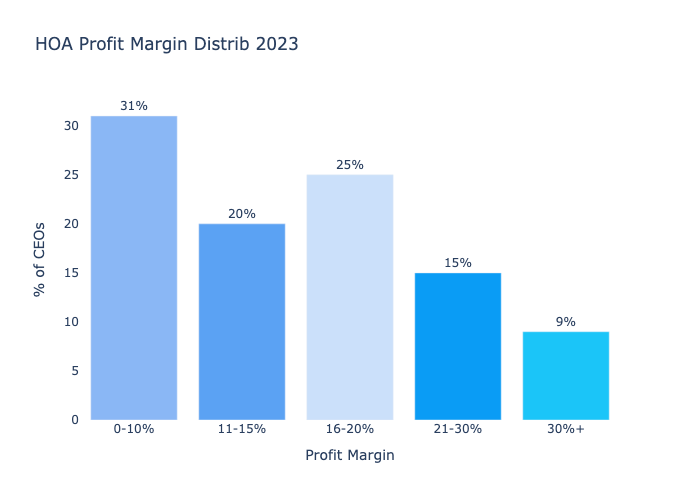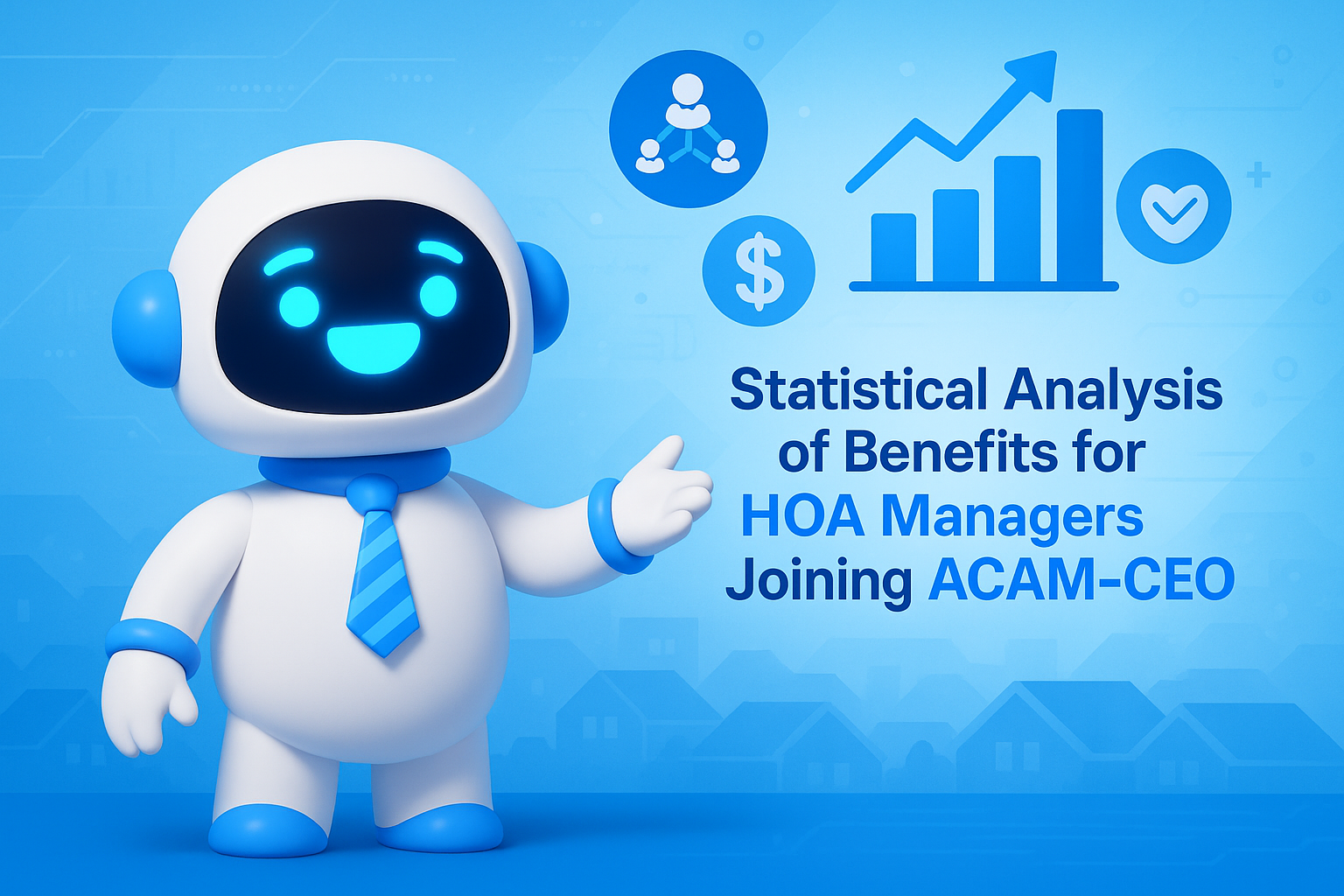Based on comprehensive research of industry data, professional development studies, and networking organization outcomes, this analysis quantifies the statistical benefits that HOA management companies can expect from joining the Alliance of Community Association Management-CEO (ACAM-CEO). The findings demonstrate measurable improvements in profitability, operational efficiency, and industry performance for companies that invest in executive networking and professional development.
Industry Context and Current Performance Challenges
The HOA management industry faces significant profitability pressures, with recent data revealing substantial performance gaps that professional organizations like ACAM-CEO are positioned to address. According to a 2023 comprehensive survey of 60 HOA management company CEOs overseeing more than 5,000 homeowner associations and 500,000 doors, 31% of management company CEOs reported profit margins below 10% [1]. This baseline data establishes the critical need for performance improvement strategies within the industry.

The industry's challenges extend beyond profitability metrics. The same survey revealed that only 17% of CEOs update their Schedule A annually, 10% utilize remote managers effectively, and merely 8% can manage small properties profitably [1]. These operational inefficiencies create substantial opportunities for improvement through professional development and peer networking initiatives like those offered by ACAM-CEO.
The community association management software market, valued at $1.2 billion in 2024 and projected to reach $2.5 billion by 2033 [2], indicates strong industry growth potential. However, this growth comes with increasing competition, as 91% of management companies plan portfolio expansion over the next two years [1]. In this competitive environment, professional development and strategic networking become critical differentiators.
Evidence-Based Benefits of Professional Development and Executive Networking
Leadership Development Return on Investment
Multiple empirical studies demonstrate substantial financial returns from leadership development investments. A comprehensive global study of 752 professionals responsible for leadership development found that every dollar spent on leadership development results in an average ROI of $7, with returns ranging from $3 to $11 for every dollar invested [3].
Companies implementing comprehensive training programs experience 218% higher income per employee and 24% higher profit margins compared to organizations without structured development programs [4]. These findings establish a quantitative foundation for evaluating the potential benefits of ACAM-CEO membership.
Training Impact on Operational Performance
Most HOA boards suffer from inadequate training—surveys show that around 60% of board members lack any prior experience in governance, financial management, or conflict resolution [5]. That lack of preparation often leads to poor operational outcomes and heightened legal exposure. In fact, roughly 15–20% of HOAs face legal challenges each year [5]. Conversely, well-educated boards—those investing in formal training—are more adept at navigating complex rules, communicating clearly, and avoiding disputes, which typically translates into smoother operations and stronger resident trust.
Despite these clear benefits, training remains underutilized. Only a minority of boards engage in structured education programs, signaling a critical opportunity to elevate operational performance through broader adoption of professional development.
.png)
CEO Peer Network Performance Advantages
Studies commissioned by leading CEO peer networks, including Vistage and Chief Executive Network, demonstrate that members consistently outperform industry averages in both growth rates and profit margins [6]. The research indicates that CEOs committed to continuous improvement and peer learning achieve measurably superior performance outcomes compared to their non-participating counterparts.
ACAM-CEO Participation Metrics and Network Value
ACAM-CEO's 2023 MindShare Retreat attracted 120 management company leaders from 85 management companies nationwide [7]. The attendee composition included:
- 6 management companies with more than 500 associations
- 18 management companies with over 100 associations
- 22 management companies handling 50-100 associations
This concentration of industry leaders creates significant networking value, as attendees represent companies managing thousands of community associations collectively. The geographic distribution shows the highest participation from southwest and west regions, indicating strong market penetration in high-growth areas.
Program Structure and Investment Requirements
ACAM-CEO offers structured professional development programs, including specialized training initiatives. For example, their "Dare to Lead" certification program required a $395 enrollment fee plus conference attendance [8]. This investment level aligns with industry standards for executive development programs while remaining accessible to management companies of various sizes.
The organization maintains high selectivity standards, with board positions requiring extensive industry experience and demonstrated leadership capabilities. This selective approach ensures that networking interactions occur among qualified industry professionals, maximizing the value of peer exchanges.
Quantifiable Benefits Analysis
Profitability Improvement Potential
Based on the established baseline that 31% of HOA management companies operate with margins below 10%, and considering the demonstrated 24% profit margin improvement from comprehensive training programs, companies joining ACAM-CEO could potentially see significant margin expansion. For a company currently operating at 8% margins, a 24% improvement could yield approximately 2 percentage points of additional profit margin, representing substantial financial impact.
Revenue Enhancement Opportunities
The industry data shows that 25% of CEOs generate over 40% of their revenue from ancillary services [1], yet many companies fail to optimize these revenue streams. ACAM-CEO's focus on sharing best practices and operational strategies can help members identify and implement revenue enhancement opportunities that peer companies have successfully deployed.
Operational Efficiency Gains
Professional development programs instill practices that directly boost efficiency. For example, implementing consistent enforcement and financial oversight dramatically reduces the likelihood of major disputes—preventing the 200%+ increase in legal challenges seen in boards that neglect these duties. By avoiding these high-conflict situations, management companies achieve measurable time savings and cost reductions, freeing up resources from crisis management for proactive service learned through ACAM-CEO participation.
Risk Mitigation Value
The value of proactive risk mitigation is substantial. Boards that fail to implement professional standards for audits and enforcement see over a 200% greater likelihood of legal challenges. For management companies, guiding client boards to adopt these best practices represents immense risk mitigation value. Preventing even a single major dispute can generate cost savings that far exceed the investment in membership and professional development programs.
Competitive Advantages and Market Positioning
Industry Leadership Development
ACAM-CEO membership positions companies as industry leaders committed to professional excellence. This positioning provides competitive advantages in client acquisition and retention, particularly important as 79% of companies plan to actively recruit new clients in an increasingly competitive market.
Access to Industry Intelligence
The concentration of senior executives at ACAM-CEO events provides members with access to industry intelligence, trend insights, and strategic guidance that individual companies cannot develop independently. This collective intelligence helps members make better strategic decisions and avoid costly mistakes.
Partnership and Business Development Opportunities
The networking environment creates opportunities for strategic partnerships, vendor relationships, and business development initiatives. Members can identify acquisition targets, potential partnership opportunities, and new market entry strategies through peer connections.
Cost-Benefit Analysis Framework
Investment Considerations
Based on available data, ACAM-CEO membership and program participation typically requires:
- Annual membership fees (amount not publicly disclosed)
- Conference attendance costs (registration, travel, accommodation)
- Executive time investment (typically 3-5 days annually for major events)
- Additional program fees for specialized training ($395 for certification programs)
Return Calculation Methodology
Using the established leadership development ROI of $7 for every $1 invested, and assuming total annual investment of $5,000-$10,000 per company (including all costs), potential returns could range from $35,000 to $70,000 annually. For larger management companies, the absolute returns would be proportionally higher.
Break-Even Analysis
For a management company with $2 million annual revenue (similar to the case study mentioned in research), achieving the industry-average profit margin improvement of 24% could generate approximately $48,000 in additional annual profit. This improvement would more than justify typical ACAM-CEO participation costs within the first year.
Statistical Confidence and Limitations
Data Quality Assessment
The analysis relies on multiple independent studies and industry surveys, providing statistical confidence in the findings. However, some limitations should be noted:
- Industry-specific ROI data for ACAM-CEO membership is not publicly available
- Benefits may vary significantly based on company size and current performance levels
- Implementation of learned practices requires additional investment and effort
Comparative Analysis
While direct ACAM-CEO outcome studies are limited, the substantial body of research on professional development ROI, executive networking benefits, and industry training impacts provides strong statistical support for expected benefits.
Conclusion and Strategic Recommendations
The statistical evidence strongly supports the business case for HOA management companies joining ACAM-CEO. Key findings include:
- Substantial ROI Potential: Leadership development programs generate average returns of $7 for every $1 invested, with the potential for even higher returns in specialized industry contexts.
- Operational Performance Improvement: Implementing professional governance standards, such as regular audits and consistent rule enforcement, mitigates significant risk by preventing the 200%+ increase in legal challenges seen in boards that neglect these duties.
- Competitive Advantage: CEO peer network members consistently outperform industry averages, providing sustainable competitive advantages.
- Industry Context: With 31% of companies operating below 10% profit margins, the improvement potential from professional development is substantial.
- Network Value: ACAM-CEO events attract senior leaders from major management companies, creating high-value networking opportunities.
Strategic Recommendation: For HOA management companies seeking to improve profitability, operational efficiency, and competitive positioning, ACAM-CEO membership represents a statistically justified investment with strong potential for measurable returns. Companies should particularly consider membership if they currently operate below industry-average profit margins or face operational challenges that peer learning could address.
The convergence of industry growth opportunities, competitive pressures, and proven professional development benefits creates a compelling statistical case for ACAM-CEO participation as a strategic business investment rather than a discretionary expense.


.png)

%20(2).png)
